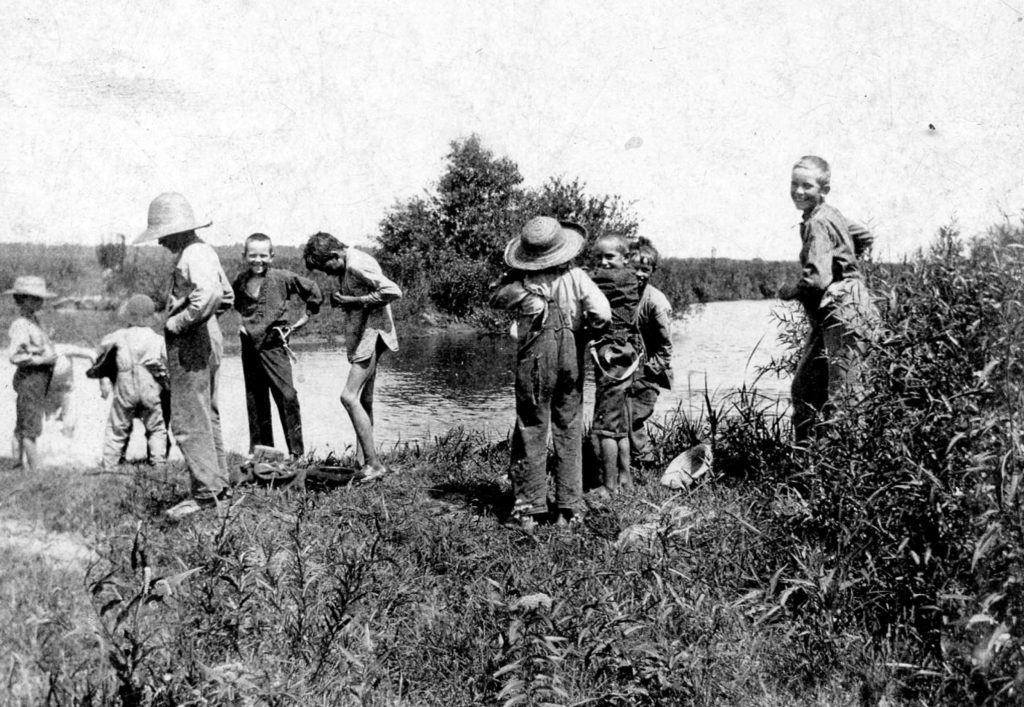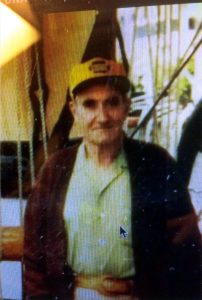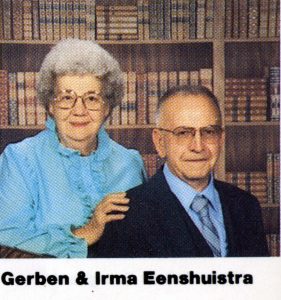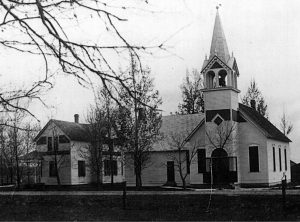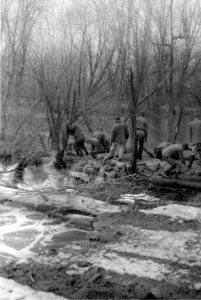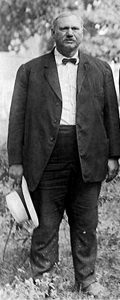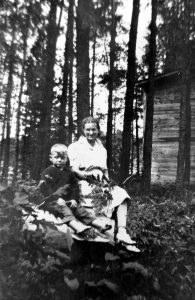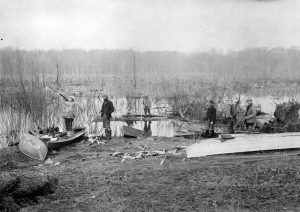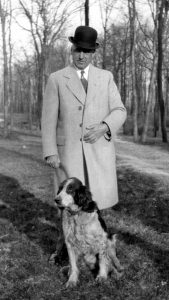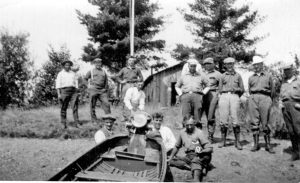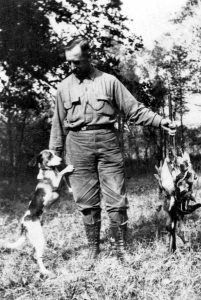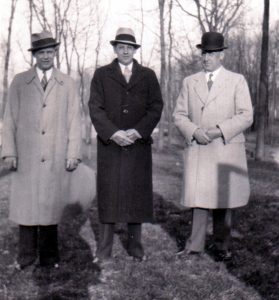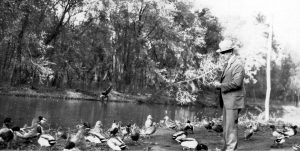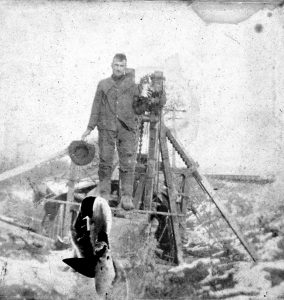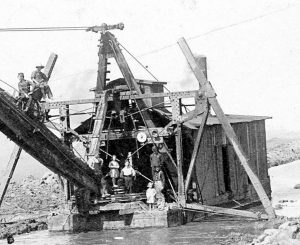Dan Tanner and Gerben Eenshuistra
Sponsored by
DeMotte-Kankakee Valley rotary Club
Oral History Project
THE SETTLING OF THE GRAND MARSH OF THE KANKAKEE
RIVER
Interview by Laverne Terpstra, Transcribed by Shirley Zeck
December 28, 1994
I was born in 1917 in DeMotte, Indiana. I am 78 years old. My folks were Dan and Elizabeth Tanner.
My name is Gerben Eenshuistra and I am 79; born in 1916. My dad’s name was Wietse, a good old-fashioned Dutch name and my mother’s name was Anna. They were born in Holland and I was born in the United States.
I (Dan) was born in DeMotte where John Klip lives (517 9th St. SW). My dad owned forty acres. That’s where I started my life. Old Doc Hewitt was the one that brought me into this world.
We lived there until I was nearly two years old. Then we moved out to the Staple place, north of DeMotte. The DeMotte airport is there now (120 Hickory NW). I lived there until I was nine years old, I had my tenth birthday back in DeMotte again where I started out in.
After I started my school training from there, it was the first time when I could walk back and forth at noontime to get my dinner. When we lived out in the country I had to carry my lunch all the time.
Of course we always raised pickles, and had to pick pickles for a living. I knew what it meant to get my back bent.
We had a ditch that ran through our farm there so I used to fish a lot in it. I used to trap and catch a few muskrats and mink and things like that and sell some hides once in a while in the winter time so I’d have some Christmas money.
We used to swim a lot down there in the Sekey’s (Sekema”s) Ditch. All the town kids, everybody I ever knew, that was their swimming hole. The ditch I am talking about is on the west side of DeMotte, at the edge of it.
The people that lived along there at the time was Koster’s down on the county road (701 15th St. SW). The DeMotte town road came back past Sekema’s (Fred Hoffman’s place at that time – 617 9th St. SW). That’s where it went through and then across the Railroad track and out past Andrew DeHaan’s (9210 W 1300 N). It eventually ran in to the Nels Morris Ditch.
This is Gerben once more. I was born in Thayer, Indiana. I lived around the DeMotte area for 79 years, right at it. It was really enjoyable living here.
I went to what we used to call Dutch Corner Church (the First Reformed Church). I went there practically all my life. I’m still around here but I’m in a wheelchair at the present time.That’s about it.
When I was younger, I used to work for the Hamstra boys; milk cows, and did a lot of farm work. And eventually bought my own farm where I am living at the present time. But I sold my farm. right now I am just existing, you might say.
My dad (Dan talking) was a cowboy when he was a young man. I don’t know how old he was but probably in his teens. He worked for the Nels Morris Cattle Company. They had range land that ran from further east of Evans’ farm (13841 N 700 W). It went clear west to what they called the Range Line Road (1200 W).
Their headquarters was there where Evans’ live now. they worked out of there but they had cattle that covered all over this part of the country.
He used to tell me stories about how he used to have to swim his horse, (it was the spring of the year) to check fences where the ice might have taken it down. This was right along where Konovsky’s Elevator and the railroad tracks are now, where Dick Peterson has that subdivision in there.
That would be all under water and he would swim his horses through there to follow these fences after the ice broke out. He’d go clear around the country wherever it went so they could keep the cattle in.
Then they had what they called Forrest city. It was out west of DeMotte along the railroad track. I can remember myself when the old cattle pens were still in there. Because they used to bring the box or cattle cars in there. They’d get all these cattle together in these pens and then they’d load them on their cars and ship them out of there to the market.
Out where the Dutch Corner church is, you go south one mile to the S bend or curve in the road there. On the northwest side of the road there is a little hill in there (10110 W 1100 N). One of the Hamstra’s did live there. I don’t know who owns it now.
Anyway, in that hill there was a dugout back in there where gangsters had a bunch of horses. They used to have horses. They’d steal horses and bring them in there. They had to swim them in there in places to get through. That’s why they had it that way so that the law couldn’t always follow them. There were sinkholes.
This is all from my dad telling me when I was a kid. He used to drive us out there once in a while just to look around and see if we could find any artifacts. Of course we never came up with anything and never dug for anything.
We used to walk around where the old dugout was in the ground where they kept their horses and lived at times when they were traveling through.
The gang was connected with the ones over near Lake Village, Beaver Lake over on U.S. 41. This gang that was working in here, they would steal horses around the community and they would swim them out there and hide them for a few days. Then they would take them on to the other places.
My dad was born back in the 1800’s so it had to be somewhere back in the 1800’s that all this was going on. This is Gerb again. We used to live on the Middleton Ranch which about one half mile west of 900 on 1100N.
If I remember right, there were about seventeen rooms in that house. Two families lived there at one time. We lived in one half and Nes Hanford and his wife and child lived in the other half.
We had a porch all the way around two-thirds of that house. We used to take our wagon and scoot all the way around and turn around and come back, day after day, after day. I never had to scoop snow. We had a good time there.
That’s when my dad worked for Richard Grevenstuk Sr. He worked for him for about four or five years. Then we moved and he worked on the old John Fase place. That’s where he passed away. This was near and west of the area where they used to steal horses.
I remember when my dad worked for Grevenstuk when he’d get a couple of loads of horses from out west. Then we’d have to break them so they could farm with them. Every year they would get about thirty or forty of them horses. He’d break some of them and he’d sell some of them. Pretty soon he’d get rid of all of them again and wait for the next year. That’s the way they operated.
Dan again. The Old Grade was started as one of the first crossroads that went from Rensselaer to DeMotte and Hebron, across the Kankakee River. This was the old Kankakee River, not the ditch they’ve got dug there now.
When they got down here to where the road (700 W & 1700 N) has four crossroads by Eenshuistra’s Farm, from there on north they had what they called a corduroy road. They built it out of logs. They would cut them, I don’t know how long, but long enough so they could pass two wagons going and coming.
They laid them side by side on top of the mud so that they wouldn’t sink to get to cross the river. When they got to the old river then they made some kind of a wooden bridge across there and went on across.
But every spring when the high water would come in it would wash the bridge out or tear it out or something. Some of the logs would pull out. When it got dry enough to where they could they would get back in there and rebuild it all again. So it was an every year kind of a project keeping the road open until later years and they were able to get bridges in.
I’m going to start by telling you about a little history that happened back next to Kaper’s subdivision. It was across south of where Red (Dick) Evans’ house is now (6972 Blackberry Court).
But anyway there was an old guy who came from Germany to this country. He was raising beef cattle to sell on the market. He had a neighbor that lived somewhere, I don’t know how close, but he decided he wanted those cattle.
Well, the old man didn’t want to sell them. So, one day the old guy disappeared. Nobody knew what happened to him. So, they started inquiring around.
This guy took all the cattle home with him. He told them that he bought all his cattle because the old man wanted to go back to Germany to live his last days. He said, “I bought everything and he shipped out and went back to Germany.”
Anyway, it went on until spring. The next spring some fishermen were floating down the old Kankakee River bed (not the new one that is there now). Here they came on to a body floating in the water.
They stopped and investigated and found out it was tied to an iron pump, sunk down in the mud. So then they called the Sheriff and had them come out there and check on it.
Well, when they finally got the old guy out of the water and got him in the boat where they could investigate him, they found out it was this guy that owned the cattle that was supposed to have gone back to Germany.
They knew then that the guy that was telling them all the stories about how he bought the cattle, hadn’t bought them at all. He had stole them and killed the old guy and threw him in the river.
So, they went and arrested the fellow and put him in the jail in Rensselaer, Indiana. Anyway, eventually they held court on him and they sentenced him to be hung.
They built a scaffold there in the Rensselaer courtyard, I guess he was the only guy that was ever hung there. They built a scaffold and were going to hang him there.
I know when my mother was just a little girl, about eleven or twelve years old, she said her mother used to tell her “Now I don’t want you girls going down there and looking at that because that isn’t nice to be seen.
But anyway when they would get out of school they’d slip around and slip down there to see what it looked like. She can remember seeing the old scaffold sitting there when they were getting it built.
They finally hung him there. Then they buried him in what they called Potters Field there in Rensselaer along the river. There is a graveyard along in there, I don’t know what they call that now anymore.
Anyway, at the end of that there is a little piece of ground they call Potters Field and that’s where they buried the murderer, the guy that did the killing.
Then, the man that owned the cattle that got killed, they buried him down here in DeMotte in the Methodist graveyard there along the railroad track. He’s got a headstone in there if anybody would like to walk down there and kind of check on it. It’s there, but you have to look pretty close because it is an old sandstone stone and it’s beginning to chip off. It is kind of hard to read the name a little bit.
Gus Safstrom is another piece of history down along the Old Grade. He lived there and bought that in the early twenties sometime, I can’t remember just exactly when.
He invented a carburetor for the Model T Ford Company and he lived off of the patent that he got from them. As the years went along, he didn’t keep his patent up or build up the carburetor to keep up with the new cars coming on. So, eventually he lost out.
As he did, he began to sell property off to kind of live on. He sold from the railroad track to the highway US 231 to different ones. He kind of subdivided. I don’t know who all bought in there but there are quite a few homes in there. Some of it has been sold and resold since.
Then he kept from the railroad back north. He worked as a bookkeeper for some company up in Chicago. He traveled back and forth on weekends. After a while he got old enough to where he couldn’t hardly make it back and forth. He retired and slowed down.
He and his wife would stay in an old house back there. He had something wrong with him. One morning he got up and told his wife he was going to work. He went out to his car and had a heart attack, I guess, as far as I know. He fell down there and it was cold. When they found him he was frozen. Florence Sekema used to go out there and help the old lady because she was an invalid too.
After that I don’t know who owned it. It kind of stayed in his company or whatever it was until Kaper’s finally bought it and subdivided it now. They are selling a lot of homes in there. Old Gus used to sell me and Ronnie Mosier pieces of ground in there. We didn’t buy the ground but we got the trees,
the lumber that was on it. Me and Ronnie would cut firewood for furnaces for people that had wood furnaces around town. Then some of the trees, white oak and that, we would make into fence posts. We would sell them.
Well, we had gotten four old Model T Fords off of some of the farmers that had them stacked up in their garages and weren’t using them anymore. We got them all running but one.
We made a trailer of the one that wouldn’t run. We used the others to pull the trailer. We used to haul the saw logs into Bert Robbins cow pasture there by their house in town and stack them up.
On weekends when Bert Robbins and George Mosier weren’t working on the county roads, they would help me and Ronnie. We took one of those cars and made a buzz saw out of it. We turned the motor sideways; got a saw from some place. I can’t remember where we bought it at. We put it on the back of it and then run a belt across to run it.
We’d fire that old Model T engine and it ran like a top.
The next weekend or even in the evening sometimes when we had time we’d sell it or haul it out to somebody that called in and wanted a load of firewood.
We did that for two or three years. One day we were out there buzzing away and all of a sudden that old Model T ford said “push”. The radiator evidently got stuck and couldn’t get the steam out and it built up a head of steam. It blew that radiator into pieces. That stopped the wood work right there.
There was a man by the name of Mr. Pon. He came out of Chicago, Illinois, bought up a lot of property out here around the DeMotte area. He had one place he called West Ponville. Another piece was called East Ponville.
East Ponville was over by 1000 N and SR 10 and West Ponville was about straight south of the Dutch Corner Church out in that area.
Anyway after he bought it he divided it up in five acre lots.
He would go into Chicago and tell people up there that were having pretty hard times how they could buy up these pieces of property so cheap, you know. It was way more ground that they could buy in Chicago. They could farm it, they could raise chickens, they could raise hogs, whatever on it, you know.
Well, those people coming out of Chicago they didn’t know any different. It looked big to them and they bought land and thought this is our chance to get rich.
Anyway, he started selling property off to them. After about so long they began to find out. You can’t raise corn in a woods. You can’t feed pigs on sandburrs. You had to buy the feed for chickens because you couldn’t raise the feed.
So, they began to lose out. They got to where they were having to live off the county and what not to survive.
Finally, some of them sold some of their property. Some of them just gave up and moved out and left it.
Anyway, it was all there and I think it’s still there.
But there are people now building nice homes back in there and everybody has more money now than what they had then. They are building nice homes back in there and making a living out of it, I guess.
There was an old guy that used to live around town here, old man Granger. He had a couple of sons. He had Jesse Granger and Buelle Granger.
Well, Jesse was a little kind of on the shady side sometimes. He was a good guy but he would think of things to do that weren’t up to par.
Anyway, this one day I came in to town. He saw me and said “Hey Dan, would you run me out to the railroad bridge out there by Grape Island?”
I said “Well, first I have some things I’ve got to do here in town”. So, I took care of my business. When I came out he was still out there waiting.
I said I could run him out there.
I took him back down on the old dirt roads and got out to where the Gifford Railroad run through. They had a fence up along the Gifford Railroad at that time because the old train was running on that track.
Anyway, we crawled over the fence and walked down the railroad track and across the bridge. When we got across the Hodge (he always wore hip boots). He pulled his hip boots up and started wading through the water.
I went as far as I could go because I didn’t have any boots. I stood there watching him and I thought how is he going to get any ducks. He promised me as long as I was going to run him out there he was going to get some ducks.
He said he would give me some for taking him out there.
But I thought how is he going to get any ducks without a gun. Well, I thought, knowing him he probably had a gun stashed way out there in a hollow tree somewhere. He will stop and pick it up.
He kept going, kept going, and I kept watching him. Finally he waved out birds of Grape Island and it was all under flood all around it.
So, pretty soon the ducks started taking off a flying. I thought, every once in a while you could see one splashing and couldn’t go anywhere. I thought what in the world is he doing now?
I would watch him. He’d walk up and would pick up a duck, wring its neck, stick it in his hunting coat, monkey around there a little bit. And pretty soon he would go over to where another was splashing around and do the same thing.
He finally ended up with a hunting coat full of wild ducks. When he got back I asked him, “How in the world do you get ducks without a gun out there?”
He said “Dan, you don’t dare use a shotgun out here. You would have everybody in the country on you. The first shot fired they would be out here looking for you. You have to do it quiet like. I got rich out there with fish line tied to them and hooks. I would bait them up with corn. When ducks came along and swallowed the corn then I got me a duck.”
I did get a couple of ducks for taking him out there. I took them home and cleaned them. My mom cooked them up and we had wild duck for dinner that day.
Back years ago the Granger family lived up and down the Kankakee River. So one of the old granddads, they called him Hank Granger, had a tavern over by Shelby, over in along there along the Kankakee River. He run that but then he moved up this way and was running.
So anyhow, when he was up here closer to DeMotte he was a guide for fishermen and duck hunters and such as that. So, one day they were trying to catch him. The Feds were trying to get him for something.
One day some guy came out there and wanted to know if he could take him out fishing. “Yeah,” Old Hank said “Sure I’ll take you out fishing”
So, they got in a boat and they went out fishing in the Kankakee River some place, I don’t know just where it was at, but somewhere out north of DeMotte. After a while the old guy wasn’t catching any fish. He said, “Is there some other way we can catch some fish?”
There are a lot of ways you can catch fish. The guy said “Could we dynamite them?” Well, Hank said, “Yeah, I suppose we could dynamite them.”
He said “Could you fix it up so we can dynamite them?” Hank said “In the morning” he said “when we get ready to go out we’ll see what we can do”.
So, during the night Old Hank, he got his dynamite sticks together or whatever he was going to use and tied it to a brick. He put a fairly short fuse on it, long enough I guess he figured he was safe.
When they got out there the next morning they were fishing and weren’t catching anything on their hooks. So, the guy said “Could you fix up anything so we could dynamite them?” “Yeah,” he said, “We’ve got some dynamite here, lets dynamite.”
Well, this guy was a Federal Man all the time and Hank had him all figured before they started. He smelled him, you know, who he was.
Anyhow, Hank said okay. He got that stick of dynamite he had tied together with that brick on it. He lit that fuse and he got it lit, and threw it over in that guys lap. He said, “There it is. Throw it in.”
They couldn’t get Hank for dynamiting. The other guy had to throw it into the water. (The Federal Man had to). So he got out of that one.
I said, “That’s the way they make a living. That’s the way he kept from getting caught a lot of times. He could smell them guys when he saw them.”
Anyway, Andy Granger used to take a lot of people duck hunting back there. His son, Jesse and all of them, they’d get barrels full of them and salt them down. Then they’d take them down to DeMotte to the depot and ship them into Chicago. I don’t know what they got out of them but evidently a pretty good price.
They’d ship them into Chicago and they’d serve them in restaurants around up there, a lot of ducks and things like that. The different kinds of fish you catch out there in the Kankakee River: There are a lot of northern, walleye, and of course carp, and suckers, bass, bullheads, and crappies and bluegills. There are just about any kind of fish you could think of in the clear water out there.
A lot of people say there’s not many fish in there. But there are fish. I catch them.
Years ago, back probably in the 1700 area, the French came to America. They started dealing with the Indians. They moved down on Grape Island, which is north of DeMotte on the west side of US 231 at about 1600N. It is back on Gerrit Van Keppel’s property.
When they came over they brought a lot of grape vines with them, pale grapes. They planted them on the island and that’s where the island got its name, Grape Island. There are still two islands in there, one they call Little Grape and one they call Big Grape.
Big Grape in on the west side of the Grape Island Ditch, I call it. It’s the ditch that runs through the Grape Island there. Little Grape is on the east side between the highway and Grape Island. You can’t see it too much unless you ride out by it.
They used to have a corncrib when potter owned it. They stacked their earcorn in there when they were picking earcorn.
Anyway, the Indians and the French developed a trading post there on Grape Island. There was a bend in the river that came up there and they called it Elkhorn Bend.
So, the French would bring whatever they had, guns, jewelry and whatever the Indians wanted and liked. And the Indians would bring their furs in there and the French would take the furs and the Indians would take what they wanted that the French brought in.
That went on for quite a few years. Eventually, some white people began to move in there and they built a log cabin in there on Grape Island.
They lived around there for quite a few years. At one time, there was a story about a ghost out there that used to follow along the Kankakee River. They said there was a guy and his wife that used to trap and live around there somewhere.
The guy went out one morning to run his traps and whatever. But he never returned. His wife stayed around and she used to watch for him. She finally died too.
So, when people said they saw a ghost out there, they claimed it was that woman looking for her husband. She would walk up and down the old riverbank. I’ve never seen her out there myself. There have been a lot of stories about different ones over the years that used to see it.
But evidently she’s quieted down and found a safe resting place, I guess. She doesn’t roam around like she used to. At least I have never seen her.
Anyway, there were some other people that moved in there and built a log cabin. They lived in there and were trappers and hunters. They were catching a lot of furs and stuff.
They accumulated quite a bit that were worth quite a bit.
One day one of the guys decided he wanted it all. So when the other guy wasn’t watching, he hit him in the head and killed him and left him in the cabin.
Then early in the morning when they figured it happened, he set the place on fire. He went into the town of Hebron and started playing cards with the other guys around town. They were playing poker and whatever.
So, they played cards pert near all day until evening before dark. He said he had to go home.
He took off and started for home. They don’t know if he ever went clear back to the cabin or not. But a little later on he came back into Hebron. He said that a terrible thing had happened. He said his cabin had burned down and his buddy burned up in it.
They got a gang together and checked it out. The cabin had burned down. I don’t know whether they found any remains of the body or not or how bad he was burned.
Anyway, it went on for years and they believed the guy that done it, that said he was in town playing cards all the time. He said he couldn’t have done it.
But they got to thinking, years ago after he passed away, that it had to be him because he was the only one that was out there. They figured he had time enough to do what he had done and then come into town and play cards for trying to make an excuse.
Now we are going to go down on Indian Gardens, west of DeMotte on Range Line Road (600 E – Hebron).
Years ago before Cameron’s bought that up, the Indians had lived there for a long time. There are graves all over that hill there. A lot of them have never been found, of course, but the Indians used to plant walnuts whenever they would bury a body.
They would plant walnuts with him. They said that was his food for the hereafter. They would always have walnuts to eat.
Anyway, when Cameron’s bought it. They dug down in there and were making a basement. They dug up a lot of Indian artifacts. They got bowls and plates, all kinds of Indian artifacts; arrows, and hammers, what not over there.
They did have it in that building. I suppose it’s all there yet. They knew that the Indians had lived there.
When I was a little boy my dad used to take back there in an old Model T ford in the spring of the year, and we would pick wild onions. We would pick up what walnuts were still laying around that was good yet that we could find.
We would always go back home and crack a few walnuts and have a some walnuts to eat. Of course, the wild onions we always ate them too. They used to grow plentiful back in there.
I don’t know whether they still do or not. They might in places.
After Cameron took it over, they made a duck hunting club out of it. For quite a few years a lot of people around DeMotte worked out there. They helped build duck pens and helped dig the ditches and what not.
They really stocked the back end of it out there in the marsh with a lot of different kinds of fish; a lot of northern, bass bluegills and croppies, such as that. Of course there were bullheads and catfish that moved in.
There was just about any kind of fish you could think of, you could catch back in there. I think you still could if you’d go back there, but of course they keep it under control and don’t allow too many people back in there anymore.
The old Grandpa Cameron that first bought the place was a “can manufacturer” in Chicago. He had the American Can Company.
He invented the cans and lids, whatever. He was the one that bought all that property up out there, Indian Gardens.
He had it fixed up for ducks and all of that. After he passed away then his oldest boy Allen took over.
Allen run it for quite a few years. But he never kept up raising the ducks like his dad did. Allen just depended on the wild ducks that were flying through to come in.
Well, he had different ones hired to patrol the place and kind of keep it where it was accessible for people to go back in there and hunt. He would have a lot of his big buddies from the Chicago area that knew him, that liked to duck hunt.
He charge them “so much” for a duck blind, so he was making a little money off that, enough to keep everything a going.
He run that for quite a few years. Now he’s probably 88 or 89 or 90 years old, somewhere in there. He might not even be living at the moment, I’m not sure.
He turned it over to his son. His son I guess is not taking too good care of it, I hear. It is kind of getting run down and things are happening out there.
They haven’t sold much of it off, other than what they sold to Gerrit Van Keppel several years ago. The rest of it they still have. They don’t do as much duck hunting and fishing back there as they used to years ago.
After Allen had it, years later Harold Hildebrandt and his wife moved in out there. They were caretakers, watching the place.
Every once in a while Camerons would get a whole gang together and want to have a party. They would call Harold or his wife or whoever answered the phone and give them an order. They had to have so many steaks, whatever they were going to have for their meal, all cooked up for them ready to serve when they got out there.
His wife always did the cooking. So she had a pretty good job to take care of when a gang like that came out.
That building, I don’t know, there must be twenty-five maybe fifty rooms upstairs in it. I know there are a dozen different bathrooms up there. They used to take me up there once in a while and we would walk around through it. One time for three or four months I was the caretaker out there. One old guy died that used to look after it by the name of Spencer. I had helped him a time or two, so Allen Cameron asked me one time if I would run it.
I said “No, I don’t want any part of it.” I had something else to do. “If you will watch it until I can find somebody to move in there” and I said, “Maybe that way. I’m ready to go to Canada on a fishing trip. When that time comes I’m going. You are going to have to find somebody pretty quick.”
Anyway, Cameron, Allen, he lived up in Walloon Lake in Michigan during the summertime. He was bothered with hay fever. It was far enough north the hay fever didn’t bother him too bad up there.
When the time came, I called him and told him. “Well, have you got somebody to take care of it because next weekend we are taking off for Canada on our fishing trip?”
He said, “I’ll have somebody. I think one of the Walstra boys that lives down the road will take care of it for a while for me.”
When the day came. He came out and said he would get one of the Walstra boys to look after it. I never went back out there to help on it anymore.
There is a place across the river from where I live, north of DeMotte called Beech Ridge. Some people by the name of Cooper live there now. They don’t own it. They used to farm it.
Their dad died and after that they kind of broke up or something. I don’t know what happened.
Then Gerrit Van Keppel owned it for a short while. Then somebody by the name of Dreary owned it for a short while. Now, I don’t know who owns it.
At one time they said somebody from New York had bought it. Different farmers around the country would rent it and farm it.
Right now I think one of the Little boys and somebody else farms the acreage over there. Coopers still live on Beech Ridge.
Years ago they used to hunt deer on there. This was back before I was born because it was way back when there was still some deer in this country. The ones we have now have been re- populated.
Back in them days they were just naturally ones that roamed here all their lives. They used to hunt them. There were quite a few deer on Beech Ridge. The reason they called it Beech Ridge was that the Indians carried in either seeds or the trees or something and planted them there.
There are beech trees that grow there and that’s something you don’t see too many around this part of the country. If you go further south in Indiana you will run into some beech trees in the forests.
But around here there are just scattered places where the Indians brought them in and planted them. I guess there are still a few beech trees over there.
LaSalle came from France, I guess. He had quite a crew of people with him and they were going to survey all this land through the Kankakee River marsh.
They started on that river that comes into the Great Lakes. They worked their way around into Lake Michigan and come up Comment in the Gary area or somewhere.
They had to ferry over the different rivers and different places until they finally got to the Kankakee River. Then they started floating down the Kankakee River to the Illinois River. Then from thee Illinois River into the Mississippi River. Then from the Mississippi River out to the Gulf of Mexico.
When LaSalle came through this part of the country he came right down through, not the new river of course, because that wasn’t dug in them days, but the old river.
There was a crook in the old river along through this marsh. It wound back and forth, it was about a quarter of a mile wide from one bend to the next bend.
It didn’t have much current in it so they just pulled their way through. They didn’t have motors. How far they went I guess they went all the way. I don’t know where they stopped.
In 1976 there was a crew of people that got a gang together. I don’t know where they started from. They were going to try and re-enact what LaSalle had done.
They had all their packs and their canoes and everything they wanted to use. They started down and were coming on their way from Kouts toward Hebron on highway 8, and a truck came along. It was after dark and they didn’t see them and struck some of them. It didn’t kill anyone, I don’t think. One guy was pretty well broke up, his legs and arms were broke.
That kind of changed their idea about what they were going to do. It was in the winter time and it was getting colder.
In the meantime, before they got down as far as we are, north of DeMotte, one of the Knapp boys
wanted to know if we could build a log cabin back there, so that when they got that far if they wanted to stay, they could stay in that log cabin.
I said we could build a log cabin. So, they got their chain saws out. We cheated a little bit. We didn’t do it like the old people, with an ax and sledge hammers. We used chain saws and cut the logs down. We built a log cabin and it is still there. It is standing up pretty good yet.
We never really completed it. We never put a floor in it and we didn’t caulk the sides and close it up.
A lot of different ones would come out there and camp in it and stay all night and maybe a week. They would fish and live in that old log cabin.
Anyway, when this accident happened up there and they got hurt, they didn’t come all the way down the Kankakee like they were going to. They figured they might get in more trouble.
So, they had themselves trucked around to the Mississippi. Then they floated down the Mississippi. I never did hear where they ended up or whether the fellow that was hurt caught up with them.
They were trying to enact LaSalle’s travels down through the Kankakee River Marsh, but they didn’t get it all done like he did.
Back years ago, me and Buelle Granger, we had what we called the Kankakee Nursery. We sold trees to the Onarga Nursery Company in Onarga, Illinois and the Egyptian Nursery in southern Illinois.
A lot of the trees went up to Chicago to street corner nurseries. We would get out here in the marsh and get a permit from Augie Johnson (or whoever owned the land up and down), Bill Fifield and some of his relation that owned land along the river where we could dig American elm and maple, sometimes ash, but not too much ash.
Anyway, we would load them on our truck. I had an old Ford truck that was just a ton and a half, flat bed straight truck. We would start to load those trees after we got them dug. We would start next to the cab on top of the truck, and then we would put one clear across and cover the roots with straw so when we wet them down they would hold moisture.
By the time we got done we had anywhere from four to five hundred or six hundred trees on a truck. You couldn’t believe it, but by the time you walked them down, and mashed them down in there, some of the last ones weren’t even on the truck.
They were stacked up on the limbs and stalks of the other trees. We would have a tail sticking out the back end of that truck for twenty or thirty feet.
Then we would take a rope and wrap it around the trees so that when we got to the end they were tied to a point.
Guys used to say it looked like a big pheasant with a tail hanging out the back going down the road.
Then we would take what rope we had left and throw it up over the cab. We would make a loop on the bumper and run the rope under the bumper and up through that loop. Then we would draw that down to get it as tight as we could get it to help hold the ends so they wouldn’t bounce and drag on the ground or fall off the truck.
When we got that done we would cover the whole works with straw and wet it down good. Then we would put a canvas over it and tie that down and take another rope and weave it back and forth to help hold that canvas on so it wouldn’t blow off and help hold the trees.
When we got all that done I would start for Onarga. We sold them thousands, and thousands of trees out of this Kankakee River Marsh. We would get trees from clear to the other side of Shelby, Indiana along the river.
We had quite a territory where we dug. One of the Onarga boys (the president of the nursery) would come out. He was the youngest boy. We called him Darb.
He’d come out and we would take him through the timber out there, and show him the trees. He would say dig me all you can get.
When I would haul the trees in there and start unloading them, they would have a bunch of guys there carrying them away from the side of the truck.
They would stack them up in their warehouse.
One day one of the guys said, “Man where do you get all of these trees?” Darb happened to be standing around there (the Onarga boy). He said, “You think we have a big nursery? You should see the one they have got. It covers all of northern Indiana.”
We did dig a lot of trees out of the Kankakee River Marsh and sold to different places. Augie Johnson used to give us permission. He said some day they are going to be all bulldozed out anyway. A lot of them have been.
We sold a few sycamore trees. Most of them were American elm, and maple, a few ash. But the, out here on the higher ground we used o sell more pinto oak than any other. The Onarga and the Gypsom Nursery said they couldn’t grow them as fast as we could dig them and we had good trees. They had to have a good root system on them all around. They didn’t want a dog root on them, they grew off on one side.
If they had a dog root we would leave it. We would cut them out, lift them up and load them up, and put them on the truck, and haul them down there. That is when we would get maybe six, seven or eight hundred trees, because they weren’t quite as big.
We would get what they called the two inch, (inch to an inch and a half in caliber). That was six inches above the ground. That’s where we would measure them. You could get a lot of those on a truck, the way we stacked them.
We had quite a business going, but finally when the Dutch Elm disease hit, we lost out. By that time the Onarga Nursery was raising a lot more of their own stuff. After World War II they were kind of short of stuff at one time, and that’s when we supplied them. After they began to catch up and they had stuff growing on their own, we finally went out of business. We closed down.
Henry Misch lived north of Kersey, Indiana. He was a farmer. He said that the Kankakee River was dug sometime in 1917. That was the year I was born.
He said he worked with the surveyors when they were going through the marsh. They had to cut the trees and get the place open wherever they could dig the ditch. If he had known what it was going to cause the river to do, he said he doesn’t think he would have worked for them.
I told him “Henry they would have dug it anyway whether you helped them or not.” He said “Yea, I expect they would of”.
He said “Dan, we could go out there and take a boat and go down that old river. You could just pull off anyplace. There weren’t any high banks or anything. There were a lot of grassy places just like a lawn out there. You could go out there and have a picnic, and get out there and fish. There were always fish. You didn’t have a problem catching fish. Now the new river – you have a big tall bank you have to slide up and down. You can’t hardly crawl up it.
At that time there wasn’t much brush on it. It was just pure sand. I guess your feet probably would slide out from under you.
Anyway, that was his impression of the Kankakee River. How long it took them in 1917 to come from where they started which was up east quite a ways (east of Kouts yet) and went to the Indiana and Illinois state line, I don’t know.
Their dredges were built on barges and they were what they called clam shells. They could more or less scoop the dirt out of water like they do now. I don’t know how long it took them tyo dig that, because they had to dig a pretty wide canal down through there.
We are getting back to Andy Granger. He had a camp out there on the river. He had it started before they dredged the river.
So when they dredged the river, they went around in front of it, which is now part of the Hodge Ditch. They dug out a piece of the old original river bed, deep enough so they could float their dredge that was on a barge.
They wintered one winter with Grangers there because they had to have coal all the time to fire the boilers of their steam engine, so they wouldn’t freeze in the wintertime.
So, they built a dike. It comes from the old Gifford Railroad back down to that pond. They had an old mule that they used to put on a two wheeled cart and haul coal. The Gifford RR would set a coal car on the track right there, by that place where they had to come up to get it.
They would run that mule up there with that cart and they would load on all day long, all they could until the train came back through. When it came back through, of course, it had to take the car with them again, because they didn’t have any bypass there to park it.
They would have enough coal to run them for quite a while. The next day, when they came through they dropped the coal car off again. They would get busy and hitch the old mule up, and get out there and haul more coal down to the barge.
Anyway, Grangers run a camp where they had guides for fishing, and duck hunting, etc. That’s the way they made their living in there.
Studebaker was one of their big clients. I can’t remember what town they were from, but it is around Michigan City, or a little further on. It is where they used to make Studebakers.
They would come to DeMotte and stop at the hotel there on the train, and stay at the hotel until they could get a livery wagon.
There was a livery stable over where the telephone company is (200 9th St. SW). It is near what used to be the big Fairchild house on the hill. Right next to it there was a livery stable where people could hire horses and buggies and go to wherever they wanted to go.
It is like they have rented cars nowadays.
Studebakers, as soon as they themselves settled down they would go up there. They would rent a wagon and a horse. Then they would take all they needed and go out there to Granger’s camp. They would stay out there and fish and hunt and do whatever they wanted to do.
That was their vacation, I guess.
Old Andy, of course, he always had all. They had their card games out there and he had the whiskey. He was kind of in the whiskey business at the time.
He was telling me about his youngest son one time. He was asking us one day what we were doing. Andy was around seventy five years old at that time when we were talking to him. We told him we weren’t doing much of anything, doing nothing.
He said, you know boys, I’ve got to tell you a story. Doing nothing is the hardest thing in the world to do. One time I was bootlegging out there and the law came in and they caught me.
They had court and everything. I had to serve two years in jail. The first day that they had me jailed, of course, they got everybody out there in the big room. Everybody that had a job was talked to. They finally got down to him and asked him what he wanted to do.
I don’t want to do anything. They said you don’t have to do anything if you don’t want to. Pretty soon here come a guard and set a chair there in the middle of the room. He said, “You can set right there.”
I sat down there and pretty soon another guard with a sawed off shotgun came and sat over in the corner. I sat there suppose a half hour or and hour.
Finally, I was getting kind of uneasy. Over on one side along some windows was a desk with some magazines on it. I thought I would get up and read one of those magazines.
I stood up to walk over there and the guard got up with his shotgun and said “What do you think you are going to do ?”
I thought I was going to get one of those magazines and read it. “No, you said you didn’t want to do anything. Now sit down there because you are not going to do anything.”
I sat back down for about a half hour or longer. Finally, I said “Guard, I think maybe I do want to do something.”
Doing nothing is the hardest thing in the world to do.
Andy Granger lived in a his camp. They had the house that they lived in built up on tall stilts. I suppose those stilts could have been six foot tall, because they were quite a ways up in the air. They were about eighteen or fourteen inches through with the logs that they cut off.
They had to build it up on account of the flood. It would flood in there every year.
They had this pond right in front of them that the dredge had cut out earlier when they first dug the new river. They kept their boats lined up in there and they swam in there. They did everything that anybody could think to do in a camp, I guess.
The pillars they had – the Gifford Railroad when it came through that part of the country, through the marsh there used a lot of flat rock and stuff. I suppose it was building stone probably being used. It was discarded and they would haul it out there by the coal car loads and dump it for fill to start the road bed through there.
They used a lot of those big chunks of rock to set these pillars on so they wouldn’t sink down into the muck or mud. There are some of those rocks in there yet. If you could dig down and scratch around you would find them.
When they dug the Hodge ditch out and cleaned it in 1975, they came through there with their dredge and one thing and another. They moved a lot of that stuff with a bulldozer when they were making room for the dredge to get through there.
A lot of it has been moved or destroyed. But I expect there are places there yet you could see if you dug around there would probably be some of that flat rock sunk down in the mud yet.
Back when we were kids here in DeMotte, they had what they called Saturday and Wednesday nights. They were shopping nights where the people would come into town and buy their groceries. The stores would stay open until probably near midnight sometimes.
We used to have an Indian that came through the country that had patented medicine that he was selling. They called him Chief Rolling Cloud. He called his medicine Ocatone.
We would put on little shows there. He had a little stand built up there on the side of the street. People would come into town and listen to him. A lot of people bought stuff. I don’t know whether it did any of them any good or not. They tried it anyway. They would brag about it. I think for several years, Marie Osting when she had her store, used to sell Ocatone in there that she ordered from him. People would buy it. It must have done somebody some good or they wouldn’t have kept buying it.
They had movies here in town that they used to have for free entertainment for the people. It would draw them in to town so they would buy more groceries, I guess.
Anyway, all the little towns around DeMotte, Wheatfield, Kniman, and I guess Thayer and different places they would put these shows on for them. Most of them were Western Shows and they were really entertaining. They were outside so everybody could watch them. They weren’t in a building or anything.
They would hang a white sheet up on the side of a building there in town and focus a picture on it. Everybody could watch it.
Years ago we used to have a Halloween party in DeMotte. Mrs. Tanner (mother) and Dan, they used to put it on.
There was an old tree limb that blew out of a tree in Jess Summers’ yard, which was right next to our property. I cut the thing all up and piled up back up there. We had quite a pile of brush.
So, about a week or so before Halloween the neighbor kids came over, (Jim Coberly’s kids). They asked my mother what Dan was going to do with that brush pile. They said they would like to have it for a Halloween party. She said “Well, I’ll ask him.
When I got home that evening she told me what they wanted. I said “Yea, that sounds like a good idea. I’ll even help them.”
I got some hot dogs and some buns, and I knew where there were a couple of apple trees out in the country. We could go and pick some apples. I’ll get the kids to ride in the truck and they can go with me. They’ll have some fun doing that, too.
About a day or so before Halloween we went out there and we picked the apples. They put them in a tub of water and they would try to catch them with their mouths, and pick them out of the tub.
We set the brush pile on fire. I suppose there were a dozen or fifteen kids, that many around there to start with.
The next year they came back and wanted to know if they could have another party. I said this time we are going to have to go someplace else to get some brush, because I am out of brush. I don’t have any more things to burn out there.
I told them to help me someday and we’ll go get a truckload. We went out to the marsh where I live at now, where my fishing cabin is.
We picked up another whole truckload of limbs and brush and stuff and hauled it and piled it up.
That year I suppose we had twenty or thirty maybe more crowd there, anyway.
It went on, I think probably a year or so after that, I built my new home where the Legion Hall used to be in DeMotte (where Postma’s Grocery Store used to be – 116 8th St. SE).
Between that and my house we stacked the brush out there. We got more hot dogs and more
everything. That year, I don’t know, there were quite a crowd out there. I don’t know if there was a hundred or not, but there was quite a few there.
It went on. Each year it kept growing. Of course, the word of mouth got around, and people got the kids coming in to it.
Anyway, I think it was the last year that my mother was still living that we had it. Art Lageveen and Bill Swart said they wanted to help us with some of this. They said we were spending a lot of money for stuff. I said I didn’t have any kids of my own, so this is just a way of getting along with them. They are future business. When I am in plumbing or selling trees, maybe I’ll sell them some stuff.
They said they still wanted to help me. I told them to do what they wanted. They gave me some cash to help buy the hot dogs and buns and pop.
My mother always baked cookies. Every year she always baked a lot of cookies for them. She was always out there with them, when she could to kind of chaperone them, and keep them going. She would tell them stories and one thing or another.
The last year when we had it, she had a heart attack and was in bed. We had a window on that side where we always held the party. She could look out the window and watch it. Some of the kids said “Dan, we would like to go in and talk to your mother. Is it okay?” I told them, “Certainly, she would be glad to have you come in and visit with her a little while.”
So, they went on in and visited with her I suppose for a half hour or so. It went on and the party was finally over at midnight or so when the kids quit coming.
In another week or so she had another attack, and that was the last of them. After that the legion took over and they wanted to call it Mrs. Tanner’s Halloween party. They would buy all the stuff. I said, “it was all right. It doesn’t make any difference to me. We just did it because the kids wanted it when we first started it. It seemed like a nice thing to do.”
After that the Legion ran it for a few years. It finally played out. I guess they couldn’t get the help and what they needed to keep it a going. That was the end of it. Nobody ever took it up again.
This concludes the interview with Dan Tanner and Gerben Eenhuistra.


